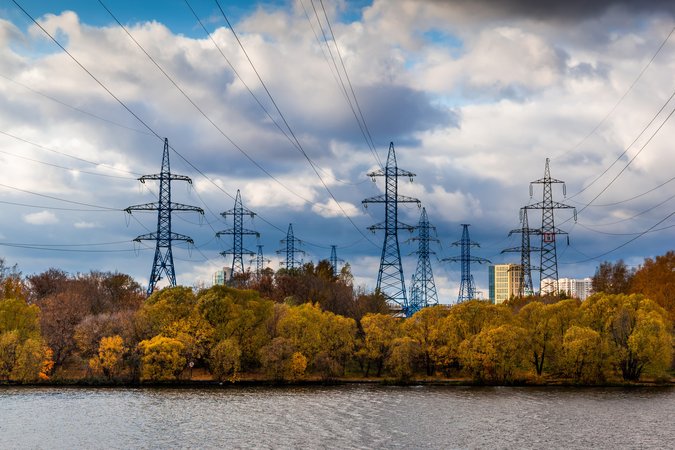Achieving Clean Electricity Generation at Least Cost to Ratepayers by 2045
A research team at RFF in consultation with the Cooper Center at the University of Virginia used RFF’s electricity planning model, Haiku, to explore potential strategies for lowering the costs of meeting Virginia Clean Energy Act emissions targets.
Executive Summary
The Virginia Clean Economy Act (VCEA) passed in 2020 requires the elimination of most CO2 emissions from Virginia’s electricity sector by 2050. The VCEA relies on four key pillars for accomplishing electricity sector decarbonization: (1) a clean energy standard, (2) joining the Regional Greenhouse Gas Initiative (RGGI) carbon pricing program, (3) a set of capacity targets for specific renewables technologies and (4) shutting down most CO2 emitting power plants by 2045. The VCEA requests that the Secretary of Natural Resources and the Secretary of Commerce and Trade report to the General Assembly by January 1, 2022 recommendations “to achieve 100 percent carbon-free electric energy generation by 2045 at least cost for ratepayers. Such report shall include a recommendation on whether the General Assembly should permanently repeal the ability to obtain a certificate of public convenience and necessity for any electric generating unit that emits carbon as a by-product of combusting fuel to generate electricity.”
To identify potential strategies for achieving least-cost decarbonization by 2045, the Virginia Department of Energy (Virginia Energy) and the Virginia Department of Environmental Quality (DEQ), with the support of the Georgetown Climate Center, led a research project to model possible strategies to achieve least-cost elimination of CO2 emissions by 2045. A research team at Resources for the Future (RFF) in consultation with the Weldon Cooper Center for Public Service at the University of Virginia (Cooper Center) used RFF’s electricity planning model, Haiku, to explore potential strategies for lowering the costs of meeting VCEA emissions targets. The Cooper Center had the primary responsibility for reporting the modeling results and evaluating other potentially important elements of a least-cost approach to decarbonizing Virginia’s electricity sector.
The results of this investigation suggest a number of key strategies for lowering the costs of decarbonization. The modeling results are broadly consistent with the results of other studies of least-cost emissions reduction. Underlying many of the specific suggestions in this report are the principle that flexibility in technology, timing and geography all contribute to lower costs. Strategies that focus directly on reducing aggregate greenhouse gas emissions tend to have lower costs than strategies that specify particular techniques or locations for achieving those emissions. Elements of a flexible approach might include:
- Technology-neutral, competitive procurement of non-emitting generation
- Procurement of non-emitting generation from the PJM interconnection region
- Emphasizing market-based approaches such as the Regional Greenhouse Gas Initiative
MODELING STRATEGY AND KEY RESULTS
RFF’s Haiku electricity model calculates the least-cost mix of electricity generation resources, given a set of input assumptions about electricity demand, generation costs and availability of renewable energy resources such as sun and wind. For this inquiry, a set of widely-used, standard assumptions from the U.S. Energy Information Administration and the National Renewable Energy Laboratory were used. The technology cost estimates are only for technologies that can be reasonably subjected to cost analysis in their current state of development. These estimates do not include technologies currently in the early stages of development. In particular, new nuclear, floating wind turbines and advanced geothermal technologies are not represented here. Should the cost of these technologies fall faster than expected, then a cost-effective strategy would include these in the mix of resources available for competitive procurement.
The Baseline Scenario reflects the current electricity sector stock of generation assets and the current policy environment, including the provisions of the VCEA such as the renewable portfolio standard, RGGI membership and the specific technology capacity goals for renewables and storage. Several results from the Baseline Scenario are true in the alternative scenarios as well:
- The four existing nuclear reactors are retained through the planning horizon
- Existing natural gas capacity is retained but with falling rates of utilization
- Utility-scale solar is the largest addition to generation capacity
- Between 2025 and 2035, the RPS is not binding (i.e. renewables investments exceed RPS requirements); offshore wind deployment substitutes for solar
- Electricity demand can be met with non-emitting resources by 2045
A series of policy scenarios were used to calculate the change in ratepayer costs likely to occur given a change in the VCEA pathway. Several possible cost-lowering adjustments were identified.
- Coal generation would retire for economic reasons by 2025
- Savings are available from the increased use of renewable energy credits from outside Virginia
- Investing in energy efficiency is cost effective, although improvements in evaluation and monitoring are necessary
- Competitive capacity procurement can result in significant savings over specific technology capacity targets
There are several possible cost-saving initiatives that were not easily incorporated into the electricity sector planning framework used in this study. In particular, enhanced grid planning and finance, more aggressive energy conservation efforts, distributed energy resources and demand management are all very fruitful areas for activities that have the potential to substantially lower the cost of decarbonization to ratepayers:
- There are potentially billions of dollars in savings from enhanced regional planning for grid modernization and finance
- The size of the energy efficiency resource may be very large but is unlikely to be be realized cost effectively without a significant investment in state agency capacity for advanced monitoring and evaluation
- Some recent studies suggest that distributed energy resources can be cost-effective notwithstanding their relatively high levelized cost of energy but further research is necessary
- Demand response, especially as EV penetrations rise, has a very large potential for cost-saving. Harvesting this resource requires a substantial investment in institutional innovation and creative tariff design
This modeling effort, along with many similar ones, indicates that eliminating CO2 emissions from Virginia’s electricity sector are technically achievable, but the approach taken to decarbonization can have a substantial effect on the cost of doing so. In the short run, much of the decarbonization effort centers around the buildout of utility-scale solar, our least expensive new energy resource, is central to a cost-effective decarbonization effort. In the medium to long term, the cost effectiveness of the energy transition will depend on maintaining a policy environment that promotes investment in least cost technologies as new clean energy and energy storage technologies emerge and the relative cost of currently available technologies continues to shift.
Read the full report here.






